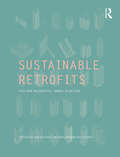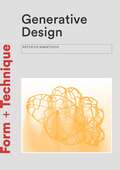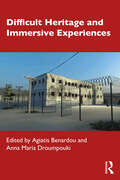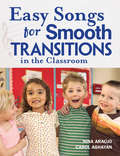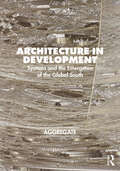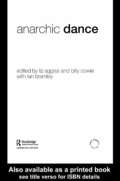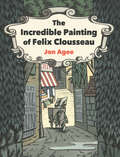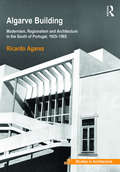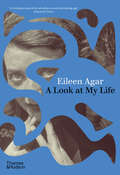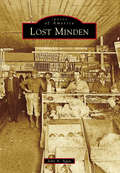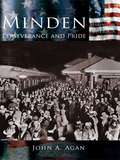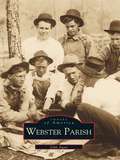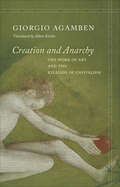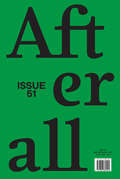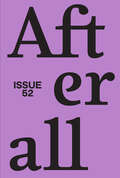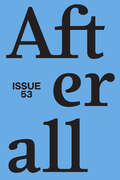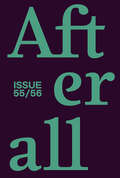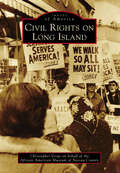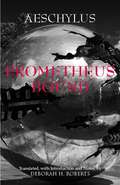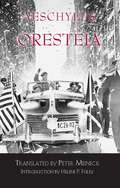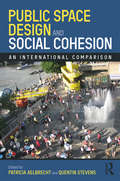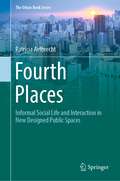- Table View
- List View
Sustainable Retrofits: Post War Residential Towers in Britain
by Asterios Agkathidis Rosa Urbano GutiérrezPresenting the state-of-the-art in sustainable retrofits in post war residential towers, this book captures and re-informs the current intense refurbishing process that is taking place in Britain, which is part of a global phenomenon happening all over the world, as cities upgrade their building stock in an attempt to comply with governmental emission reduction targets. The authors present inspections of 20 sustainably retrofitted social housing towers, analysing their aesthetic and technical modifications, as well as the shifts occurring in their social structure. The authors use over 200 full colour plans, elevations, photographs, maps and illustrations to beautifully support the statistical and analytical information collected. Finally they include interviews with some of the architects who designed the retrofits, residents and key stakeholders to inform the conclusions.
Generative Design
by Asterios AgkathidisGenerating form is one of the most fundamental aspects of architectural education and practice. While new computational tools are enabling ever more unpredictable forms, critics argue that this leads to a disconnection between architectural output and its context.This attractive, pocket-sized book uses 11 different architectural projects to explore how generative design processes can integrate digital as well as physical design tools and techniques to produce innovative forms that cohere with structural and material principles, performance and context.Illustrated with drawings, computer images and models, this stimulating, accessible handbook of ideas provides a guide for students as well as an inspiration for practising architects.
Generative Design (Form + Technique)
by Asterios AgkathidisGenerating form is one of the most fundamental aspects of architectural education and practice. While new computational tools are enabling ever more unpredictable forms, critics argue that this leads to a disconnection between architectural output and its context.This attractive, pocket-sized book uses 11 different architectural projects to explore how generative design processes can integrate digital as well as physical design tools and techniques to produce innovative forms that cohere with structural and material principles, performance and context.Illustrated with drawings, computer images and models, this stimulating, accessible handbook of ideas provides a guide for students as well as an inspiration for practising architects.
Difficult Heritage and Immersive Experiences
by Agiatis Benardou and Anna Maria DroumpoukiDifficult Heritage and Immersive Experiences examines the benefits involved in designing and employing immersive technologies to reconstruct difficult pasts at heritage sites around the world. Presenting interdisciplinary case studies of heritage sites and museums from across a range of different contexts, the volume analyzes the ways in which various types of immersive technologies can help visitors to contextualize and negotiate difficult or sensitive heritage and traumatic pasts. Demonstrating that some of the most creative applications of immersive experiences appear in and at museums and heritage sites, the book showcases how immersive technologies offer the possibility of confronting and disputing presumptions and prejudices, triggering responses, delivering new knowledge, initiating dialogue and challenging preexistingnotions of collective identity. The book provides a conceptual, as well as a hands-on, approach to understanding the use of immersive technologies at sensitive sites around the globe. Difficult Heritage and Immersive Experiences is essential reading for researchers and students who are interested in, or engaged in the study of, cultural heritage, memory, history, politics, dark tourism, design and digital media or immersive technologies. The book will also be of interest to museum and heritage practitioners.
Easy Songs for Smooth Transitions in the Classroom
by Carol Aghayan Nina AraújoSing your way through difficult times of the day and watch your job get easier!Young children in school go through many transitions throughout the day. What can make ten children settle down, clean up, and move from room to room without protest?Even if you're uncomfortable singing in public, the simple songs in this book will help you glide smoothly through tough transitions such as greetings and good-byes, calling attention, cleaning up, moving, waiting, and slowing down. Children will feel more powerful and in control, reducing stress levels during the more difficult times in your day. You will learn songs that everyone will love singing, including:"Get On Board, Little Children" and "We're On Our Way," which move toe-tapping children in and out of the classroom"Go to Sleep, My Little Pumpkins," which helps kids wind down for naptime"Cleaning Spirit," which acknowledges children as they clean up the classroomMultiple songs for each transition area, a transition planning guide, and lyrics to all 69 songs-formatted so you can easily create your own song cards-are included.
Architecture in Development: Systems and the Emergence of the Global South
by AggregateThis extensive text investigates how architects, planners, and other related experts responded to the contexts and discourses of “development” after World War II. Development theory did not manifest itself in tracts of economic and political theory alone. It manifested itself in every sphere of expression where economic predicaments might be seen to impinge on cultural factors. Architecture appears in development discourse as a terrain between culture and economics, in that practitioners took on the mantle of modernist expression while also acquiring government contracts and immersing themselves in bureaucratic processes. This book considers how, for a brief period, architects, planners, structural engineers, and various practitioners of the built environment employed themselves in designing all the intimate spheres of life, but from a consolidated space of expertise. Seen in these terms, development was, to cite Arturo Escobar, an immense design project itself, one that requires radical disassembly and rethinking beyond the umbrella terms of “global modernism” and “colonial modernities,” which risk erasing the sinews of conflict encountered in globalizing and modernizing architecture. Encompassing countries as diverse as Israel, Ghana, Greece, Belgium, France, India, Mexico, the United States, Venezuela, the Philippines, South Korea, Sierra Leone, Singapore, Turkey, Cyprus, Iraq, Zambia, and Canada, the set of essays in this book cannot be considered exhaustive, nor a “field guide” in the traditional sense. Instead, it offers theoretical reflections “from the field,” based on extensive archival research. This book sets out to examine the arrays of power, resources, technologies, networking, and knowledge that cluster around the term "development," and the manner in which architects and planners negotiated these thickets in their multiple capacities—as knowledge experts, as technicians, as negotiators, and as occasional authorities on settlements, space, domesticity, education, health, and every other field where arguments for development were made.
Anarchic Dance
by Liz Aggiss Billy Cowie Ian BramleyLiz Aggiss and Billy Cowie, known collectively as Divas Dance Theatre, are renowned for their highly visual, interdisciplinary brand of dance performance that incorporates elements of theatre, film, opera, poetry and vaudevillian humour. Anarchic Dance, consisting of a book and DVD-Rom, is a visual and textual record of their boundary-shattering performance work. The DVD-Rom features extracts from Aggiss and Cowie's work, including the highly-acclaimed dance film Motion Control (premiered on BBC2 in 2002), rare video footage of their punk-comic live performances as The Wild Wigglers and reconstructions of Aggiss's solo performance in Grotesque Dancer. These films are cross-referenced in the book, allowing readers to match performance and commentary as Aggiss and Cowie invite a broad range of writers to examine their live performance and dance screen practice through analysis, theory, discussion and personal response. Extensively illustrated with black and white and colour photographs Anarchic Dance, provides a comprehensive investigation into Cowie and Aggiss’s collaborative partnership and demonstrates a range of exciting approaches through which dance performance can be engaged critically.
The Incredible Painting of Felix Clousseau
by Jon AgeeArt imitates life in this hilarious, absurdist picture book--one of Jon Agee's most beloved titles, now back in print."Outrageous!" the judges cried. "Ridiculous!" Who would dare enter a portrait of a duck in the Grand Contest of Art? But when Felix Clouseau's painting quacks, he is hailed as a genius. Suddenly everyone wants a Clousseau masterpiece, and the unknown painter becomes an overnight sensation. That's when the trouble begins.
Algarve Building: Modernism, Regionalism and Architecture in the South of Portugal, 1925-1965
by Ricardo AgarezForeword by Adrian Forty. The Algarve is not only Portugal’s foremost tourism region. Uniquely Mediterranean in an Atlantic country, its building customs have long been markers of historical and cultural specificity, attracting both picturesque driven conservatives and modernists seeking their lineage. Modernism, regionalism and the ‘vernacular’ – three essential tropes of twentieth-century architecture culture – converged in the region’s building identity construct and, often the subject of strictly metropolitan elaborations, they are examined here from a peripheral standpoint instead. Drawing on work that won the Royal Institute of British Architects President’s Award for Outstanding PhD Thesis in 2013, Algarve Building challenges the conventional inclusion of Portuguese modern architecture in ‘Critical Regionalism’ narratives. A fine-grain reconstruction of the debates and cultures at play locally exposes the extra-architectural and widely participated antecedents of the much-celebrated mid-century shift towards the regional. Uncelebrated architects and a cast of other players (clients, officials, engineers and builders) contributed to maturing a regional strand of modern architecture that, more than being the heroic outcome of a hard-fought ‘battle’ by engaged designers against a conservative establishment, became truly popular in the Algarve. Algarve Building shows, more broadly, what the processes that have been appropriated by the canon of architectural history and theory – such as the presence of folk traditions and regional variation in learned architecture – stand to gain when observed in local everyday practices. The grand narratives and petites histoires of architecture can be enriched, questioned, revised and confirmed by an unprejudiced return to its facts and sources – the buildings, the documents, the discourses, the agents and the archives.
A Look at My Life
by Eileen AgarA beautiful new edition of the long out-of-print autobiography of the pioneering Surrealist artist Eileen Agar. Whether dancing on the rooftops in Paris, sharing ideas with Pablo Picasso, or gathering starfish on the beaches of Cornwall, Eileen Agar transformed the everyday into the extraordinary. Her legacy as a pioneering figure in the surrealist movement is firmly established, and her work continues to captivate audiences with its otherworldly beauty and imaginative power. Agar’s life was no less extraordinary than her art. In A Look at My Life, she traces her life from her birth in Argentina to the late 1980s. She gives an intimate account of very different worlds: grand house parties in Buenos Aires and Belgravia as a young girl give way to la vie bohème in London and Paris and a peripatetic existence with her lifelong partner, Hungarian writer Joseph Bard. She enjoyed enriching friendships with contemporaries Paul Nash, Ezra Pound, Evelyn Waugh, Gertrude Hermes, and Henry Moore, while a summer spent in the South of France with Picasso, Lee Miller, and Man Ray had a lasting impact. Agar introduces them and many others into the narrative of her artistic development; above all, it is Agar’s own unwavering resilience, infectious energy, and drive that permeates this compelling memoir. Bringing her work to life in all its vibrancy and variety, this updated autobiography is populated with Agar’s personal selection of photographs of family, friends, and lovers alongside over fifty color illustrations of collages, paintings, and assemblages spanning her life’s work.
Lost Minden (Images of America)
by John A. AganMinden has transformed quite a bit since Charles Vedeer founded it in 1835. The town has suffered damages of the Civil War and Reconstruction and between 1872 and 1933 the devastation of five fires and a killer tornado. Despite disaster, Minden continues to progress, but adaptation and rebuilding have caused many familiar landmarks to vanish from the local landscape. The 1902 fire led to the enactment of a city ordinance banning wooden structures downtown; as a result, many edifices were reconstructed. Today, not a single building in the business district predates the 1870s, and the roles of those still standing--such as the First National Bank, which is expected to reopen as a restaurant--are continually changing. In 1918, another fire destroyed the Minden Lumber Mill, the town's largest industry. Later in the 20th century, the development of a city government complex demolished an entire shopping district, the 1905 Webster Parish Courthouse, and Minden City Hall. Lost Minden captures catastrophes, celebrations, storefronts, and back streets that otherwise only remain in memories. ?John Agan is a lifelong Minden resident who has been actively involved in local history writing and research for more than 30 years. In the course of these activities, he accumulated most of the vintage photographs in this volume that depict the Minden that has since been "lost."
Minden Perserverance and Pride: Perseverance Of Pride (Making of America)
by John A. AganThe beautiful historic town of Minden is tucked up in the pine-filled hills of northern Louisiana. Established by Charles Hanse Veeder in 1835, a third-generation German-American originally from upstate New York, Minden rapidly earned a reputation as a town of unique character, aided by the Minden Academy and the early introduction of the Methodist, Baptist, and Episcopalian religions. After Veeder left the town, the hearty settlers remained to foster Minden's growth and development. Although the seat of Webster Parish today, Minden has faced expansion fluctuations, caused by natural disaster and economic hardship, but followed by ambitious industrial endeavors and renewed hope.Minden thrived commercially, with economic gain centralized in Bayou Dorcheat, which was composed of separate landings acting as shipping points for goods coming from much of northern Louisiana. Industries like cotton farming and the Minden Lumber Mill, formed in 1901 as one of the largest mills in the United States at the time, caused the town's population to nearly double in just ten years. Under the leadership of great men like E.S. Richardson, Minden also became a model for other towns of similar size in the field of education. At the same time, disastrous fires, a catastrophic tornado, and the devastation of the steamboat trade on Bayou Dorcheat by the coming of the railroad challenged the community in the ever-changing twentieth century.
Webster Parish
by John AganAlthough Webster Parish was not founded until 1871, the settlement of the area began as early as 1818 in southern parts of the parish as well as in areas east of the parish's lifeline, Dorcheat Bayou. The town of Minden had been the economic center of the old Claiborne Parish since the 1840s and would go on to become the seat of Webster Parish. While Minden and the southern part of the parish had a varied economic base and a relatively slow and steady growth, the northern end of the parish experienced a much different pattern of expansion. Settlement in the areas of Springhill and Cotton Valley did not begin in large scale until the arrival of the railroad around 1900, but the timber industry and the oil boom caused these areas to develop rapidly. Pictures of the growth emerging from the Cotton Valley Oil Field and the presence of International Paper in Springhill give the reader a glimpse of how northern Webster Parish emerged during the twentieth century. Additional photographs of people, homes,and businesses throughout the parish complete the story of life in a long-ago era, a time marked by a growing prosperity in a young and optimistic America.
Creation and Anarchy: The Work of Art and the Religion of Capitalism (Meridian: Crossing Aesthetics)
by Giorgio Agamben , L.P.C.Creation and the giving of orders are closely entwined in Western culture, where God commands the world into existence and later issues the injunctions known as the Ten Commandments. The arche, or origin, is always also a command, and a beginning is always the first principle that governs and decrees. This is as true for theology, where God not only creates the world but governs and continues to govern through continuous creation, as it is for the philosophical and political tradition according to which beginning and creation, command and will, together form a strategic apparatus without which our society would fall apart. The five essays collected here aim to deactivate this apparatus through a patient archaeological inquiry into the concepts of work, creation, and command. Giorgio Agamben explores every nuance of the arche in search of an an-archic exit strategy. By the book's final chapter, anarchy appears as the secret center of power, brought to light so as to make possible a philosophical thought that might overthrow both the principle and its command.
Dancers of the Dawn (Dancers of the Dawn #1)
by Zulekhá A. AfzalDeep in the desert a storm is brewing. The first in a slow burning romantasy. 'Enchanting.' Katharine Corr, co-author of Daughter of Darkness Under the blazing sun, an elite troupe of dancers are trained to harness their magic. They are the queen&’s most formidable assassins. Aasira has one of the rarest talents – for she is a flame-wielder. Feared by all and envied by some, she uses her power to execute enemies of the crown. Aasira&’s greatest wish is to serve her queen. But on the eve of her graduation, with tensions rising among the dancers and secrets stirring in the shifting sand dunes, she begins to question whether she was truly born to kill… &‘A sweeping adventure of secrets, betrayals and alternate histories.&’ Kendare Blake, author of Champion of Fate &‘Completely addictive. An absolute must read.&’ Rosie Talbot, author of Sixteen Souls
Afterall: A Journal of Art, Context and Enquiry, volume 51 number 1 (Spring 2021)
by Afterall: A Journal of Art, Context and EnquiryThis is volume 51 issue 1 of Afterall: A Journal of Art, Context and Enquiry. Afterall is a journal of contemporary art that provides in-depth analysis of art and its social, political, and philosophical contexts. Each issue provides the reader with well-researched contributions that discuss each artist's work from different perspectives. Contextual essays and other texts discussing events, works, or exhibitions further develop the thematic focus of each issue.
Afterall: A Journal of Art, Context and Enquiry, volume 52 number 1 (Autumn/Winter 2021)
by Afterall: A Journal of Art, Context and EnquiryThis is volume 52 issue 1 of Afterall: A Journal of Art, Context and Enquiry. Afterall is a journal of contemporary art that provides in-depth analysis of art and its social, political, and philosophical contexts. Each issue provides the reader with well-researched contributions that discuss each artist's work from different perspectives. Contextual essays and other texts discussing events, works, or exhibitions further develop the thematic focus of each issue.
Afterall: A Journal of Art, Context and Enquiry, volume 53 number 1 (Spring 2022)
by Afterall: A Journal of Art, Context and EnquiryThis is volume 53 issue 1 of Afterall: A Journal of Art, Context and Enquiry. Afterall is a journal of contemporary art that provides in-depth analysis of art and its social, political, and philosophical contexts. Each issue provides the reader with well-researched contributions that discuss each artist's work from different perspectives. Contextual essays and other texts discussing events, works, or exhibitions further develop the thematic focus of each issue.
Afterall: A Journal of Art, Context and Enquiry, volume 54 number 1 (Autumn/Winter 2022)
by Afterall: A Journal of Art, Context and EnquiryThis is volume 54 issue 1 of Afterall: A Journal of Art, Context and Enquiry. Afterall is a journal of contemporary art that provides in-depth analysis of art and its social, political, and philosophical contexts. Each issue provides the reader with well-researched contributions that discuss each artist's work from different perspectives. Contextual essays and other texts discussing events, works, or exhibitions further develop the thematic focus of each issue.
Afterall: A Journal of Art, Context and Enquiry, volume 55-56 number 1 (Spring 2023)
by Afterall: A Journal of Art, Context and EnquiryThis is volume 55-56 issue 1 of Afterall: A Journal of Art, Context and Enquiry. Afterall is a journal of contemporary art that provides in-depth analysis of art and its social, political, and philosophical contexts. Each issue provides the reader with well-researched contributions that discuss each artist's work from different perspectives. Contextual essays and other texts discussing events, works, or exhibitions further develop the thematic focus of each issue.
Civil Rights on Long Island (Images of America)
by African American Museum of Nassau County Christopher Claude VergaLong Island has been in the corridors of almost all major turning points of American history, but Long Island has been overlooked as a battleground of the civil rights movement. Since early colonization by the English settlers in the 17th century, the shadow of slavery has bequeathed a racial caste system that has directly or indirectly been enforced. During World War II, every member of society was asked to participate in ending tyranny within European and Asian borders. Homeward-bound black soldiers expected a societal change in race relations; instead they found the same racial barriers they experienced prior to the war. They were refused homes in developments such as Levittown, denied mortgages, and had their children face limited educational opportunities. Collective efforts from organizations such as Congress of Racial Equality (CORE) and the National Association for the Advancement of Colored People (NAACP) employed civil disobedience as a tactic to fracture racial barriers.
Prometheus Bound
by Aeschylus Deborah RobertsThis is an outstandingly useful edition of Prometheus Bound. The translation is both faithful and graceful, and the introduction to this difficult play is a model of clarity, intelligence, and a profound familiarity with the workings of Greek myth, Greek literature, and literature in general. --Rachel Hadas, Department of English, Rutgers University
Oresteia: Volume I: The Oresteia (Hackett Classics)
by Aeschylus Peter Meineck Helene P. FoleyMeineck's translation is faithful and supple; the language employed is modern without betraying the grandeur and complexity--particularly the images--of the Aeschylean text. After reading this translation, one has but one further wish: to see it and hear it at Delphi, Epidaurus or Syracuse. --Herman Van Looy, L'Antiquite Classique
Public Space Design and Social Cohesion: An International Comparison
by Patricia Aelbrecht Quentin StevensSocial cohesion is often perceived as being under threat from the increasing cultural and economic differences in contemporary cities and the increasing intensity of urban life. Public space, in its role as the main stage for social interactions between strangers, clearly plays a role in facilitating or limiting opportunities for social cohesion. But what exactly is social cohesion, how is it experienced in the public realm, and what role can the design of city spaces have in supporting or promoting it? There are significant knowledge gaps between the social sciences and design disciplines and between academia and practice, and thus a dispersed knowledge base that currently lacks nuanced insight into how urban design contributes to social integration or segregation. This book brings together scholarly knowledge at the intersection of public space design and social cohesion. It is based on original scholarly research and a depth of urban design practice, and analyses case studies from a variety of cities and cultures across the Global North and Global South. Its interdisciplinary, cross-cultural analysis will be of interest to academics, students, policymakers and practitioners engaged with a range of subject areas, including urban design, urban planning, architecture, landscape, cultural studies, human geography, social policy, sociology and anthropology. It will also have significant appeal to a wider non-academic readership, given its topical subject matter.
Fourth Places: Informal Social Life and Interaction in New Designed Public Spaces (The Urban Book Series)
by Patricia AelbrechtThis book challenges current views that public life is in decline and that contemporary urban design trends reliant on privatisation, control, events, and thematic designs are to be blamed. Drawing on detailed and extensive analysis of a case study that illustrates well such urban design trends, it shows that informal social life and interaction occur more than its necessary in new master planned environments and new designed public settings, whether public or private owned and/or managed. Furthermore, it reveals the existence of a new category of informal public social settings which it calls fourth places because of their close relationship to Oldenburg’s third places in terms of social and behavioural characteristics – radical departure from the routines of home and work, inclusivity and social comfort – but distinct in terms of activities, locations and spatial conditions – being characterised by spatial, temporal and managerial in-betweenness, i.e. indeterminacy in form, function and times, and a great sense of publicness.The acceptance of these findings problematises well-established urban design theories about master planning, expands existing social theories about the optimal conditions for public social life by empirically and spatially elaborating on them and redefines several spatial concepts for designing public space in relation to the specific dynamics of informal social interaction. More importantly, it brings optimism to urban design practice, offering new insights into designing more lively and inclusive public spaces.
